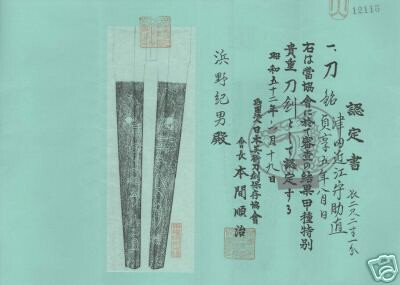-
Posts
4,155 -
Joined
-
Last visited
-
Days Won
31
Content Type
Profiles
Forums
Events
Store
Downloads
Gallery
Everything posted by Grey Doffin
-
Yep, San Gatsu, March. Grey
-
I believe this is Yoshimitsu and Showa Ju Hachi Nen Ni Gatsu (February of 1943). Grey
-
Hi Chris, Seki Mifuku Masayuki Saku, I believe. Grey
-
Steve, can I ask you where you found this information? I'm puzzling over this soemei with a friend who can read Japanese and he couldn't find reference to Tadatsuna's family name in his references. Thanks, Grey
-
Thank you Steve; now I understand. Grey
-
Interesting and thanks all. I found this on wikipedia: https://en.wikipedia.org/wiki/Azai_clan and this: https://en.wikipedia.org/wiki/Azai_Nagamasa Which leads to a question: if the Azai were obliterated by Nobunaga in the 16th century, can we assume Tadatsuna, who worked in the 17th century, was making the sword for a descendant who had no official position or did the remnants of the clan make a come back and reestablish importance? Grey
-
Hi Bruce, Unfortunately, Mr. Plimpton is not available for correspondence. I'm sure that when he acquired this sword he went with the information of the time and called it what he called it. Nothing more to add. Grey
-
Yes Bruce, a word for word quote. Grey
-
Hi guys, I, along with Mark Jones, Matt Jarrell, and Eric Molinier, purchased the Plimpton collection and have been selling it. This sword was in the collection but it wasn't sold on ebay by any of the 4 of us; it was sold some time back to a different sword dealer and he has placed it on ebay. We want all of you to know that when we are the sellers we will be honest in our descriptions and we will stand behind them. I think the sword's buyer should contact the seller and ask to return it. Although I am not responsible for this sale, I would like to mention that the seller may have been relying on John Plimpton's description of the sword in his soon to be published book: "ARMY NAVY LATE WAR. These swords were made near the very end of the war by the Tokugawa naval arsenal in Aichi Prefecture. Many of them have mixed army and navy fiittings. All of them have navy arsenal stamps, stainless steel blades, and black lacquer scabbards. In rare cases the tang is signed." Mr Plimpton has not been in good health and his description likely was written before modern research into the souvenir swords. That said, if the buyer is unhappy he should contact the seller; no honest seller wants dissatisfied buyers. Thanks, Grey
-
Hi guys, Harry Watson, in his translation of Nihonto Koza, says that Nidai Tadatsuna signed with "a soemei of Asai Uji on the ura". What does Asai Uji mean in English? Thanks, Grey
-

Tokubetsu Kincho Nintei-sho papers
Grey Doffin replied to kissakai's topic in General Nihonto Related Discussion
Hi Grev, There was the Koshu Tokubetsu Kicho paper (see below) that was a higher paper than Tokubetsu Kicho. Also, the 1st Juyo papers date to 1958, well before Kicho and higher were replaced by Hozon and higher. Grey -

Tokubetsu Kincho Nintei-sho papers
Grey Doffin replied to kissakai's topic in General Nihonto Related Discussion
If I understand the question: Tokubetsu Kicho are not on the same level as Juyo. I came to Nihonto about the time that the NBTHK made the change from Kicho and above to Hozon and above. At that time I was told that they were also upping their expectations to qualify for a paper: Hozon would roughly equal the old Tokubetsu Kicho and Tokubetsu Hozon would roughly equal the old Koshu Tokubetsu Kicho. Not all of the old papers are suspect. An old green paper to Muramasa or Masamune on a sword or Nobuiye or Kaneiye on a tsuba, say, are to be eyed suspiciously but, for less important artists, not so much. Grey -
Hi Dan, I don't plan to attend that one; sorry. Grey
-
Hi guys, I haven't posted here for a while; thought I should stir the pot. I just listed a lovely signed and papered katana with itomaki no dachi koshirae: all of it in excellent condition. https://www.japaneseswordbooksandtsuba.com/store/swords/q642-signed-papered-katana-itomaki-no-dachi-koshirae I know there have been newer collectors here on NMB asking about possible purchases. They could do a whole lot worse than this one. And as long as I'm tooting my horn, I don't understand why I still own this Hojoji Kunimasa katana: https://www.japaneseswordbooksandtsuba.com/store/swords/q404-long-katana-hojoji-kunimasa Give it a look. Cheers, Grey
-
With the understanding that I haven't seen the sword in hand (it may be wonderful) and also, since I do sell swords, I have a dog in this fight, I think you can do better for the money. 4,500 GBP is about US$6,150; I would expect something more exciting than unsigned Jumyo in shirasaya with a paper for that amount. Grey
-

Mei with chrysanthemum crest
Grey Doffin replied to Cookie_Monstah47's topic in Translation Assistance
I think it is shiny because the habaki protected it from corrosion. Grey -

Mei with chrysanthemum crest
Grey Doffin replied to Cookie_Monstah47's topic in Translation Assistance
Hi Khalid, Pretty sure this is a broken sword and you're looking at the lower half. This is close to being worthless in an informed market. Grey -

Mei with chrysanthemum crest
Grey Doffin replied to Cookie_Monstah47's topic in Translation Assistance
Hi Khalid, The mei is Tango no Kami Fujiwara Kanemichi and on the reverse Kiku Ichi. It is a real Japanese sword but that doesn't mean the signature isn't a forgery; may or may not be. Tango no Kami means Lord of Tango, which is an honorary title. Fujiwara is a clan name and Kanemichi is the smith's name. The kiku is the imperial crest and ichi means the # 1. Not sure if any old smith could use the kiku or if permission had to be granted. Pictures of the rest of the long tanto would tell us more. Tanto don't usually have shinogi (the ridge line). If the sugata is shinogi zukuri (with ridge and yokote markig the kissaki), this may be the end of a broken sword with a forged signature. Grey -
Hi Chris, Without having cracked a book I vote fake signature. This looks like it was cut with a Dremel (rotary) tool, not with a chisel. Even without the telltale rotary marks, the mei is clumsy, nothing like those of a group who had quite fluid signatures. You will have no trouble finding true signatures online and you will easily see the difference. Grey
-

Saya sizing question
Grey Doffin replied to Jeff fromNYC's topic in General Nihonto Related Discussion
Hi Jeff, The saya should match quite closely the fuchi and seppa should be slightly larger. Grey -
Hi guys, I have gotten involved with the cartel that is selling the Plimpton collection of Japanese civil & diplomatic swords; I just listed my 1st from the collection to my site. https://www.japaneseswordbooksandtsuba.com/store/swords/s142-type-19-civil-%26-diplomatic-official-dress-sword-plimpton-collection# Check it out if you're interested; this one is in exceptionally fine condition. Thanks, Grey
- 1 reply
-
- 4
-

-

strangs marks on tang of sword help
Grey Doffin replied to zak1189's topic in General Nihonto Related Discussion
I agree and will add that it wasn't very well done; the nakago is weak. I think this was put together out of existing parts. Grey -

Advice on a potential purchase
Grey Doffin replied to John F's topic in General Nihonto Related Discussion
Hi John, A paper from the NBTHK usually carries more weight than one from other organizations, both here in the west and in Japan. If you are buying the sword from a dealer in Japan, you have to figure that he knows this as well as anyone does, and that he may have submitted the blade to the NBTHK (why wouldn't he; he's there) and received an answer he liked less than the one he got from the NTHK-NPO. I can't say for sure that this is what happened, maybe he was satisfied with the NPO paper or maybe it is a consigned sword and the owner didn't want a new paper or who knows why, but it is a possibility. You might ask the dealer if it has been submitted to the NBTHK and if not would he be willing to do that to clinch the sale. Might be interesting to see his answer. Grey -

strangs marks on tang of sword help
Grey Doffin replied to zak1189's topic in General Nihonto Related Discussion
Or it is possible that this is a low grade fake; the file marks stop too low on the nakago. Pictures of the rest of the blade might help. Grey




